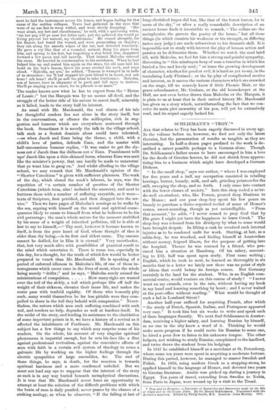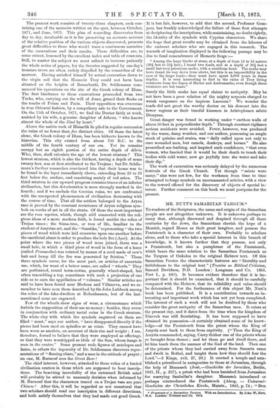SCHLIEMANN'S TROY."*
ALL that relates to Troy has been eagerly discussed in every age. In the volume before us, however, we find not only the latest theories, but the presentation of results as tangible as they are interesting. In half-a-dozen pages prefixed to the work is de- scribed a career possible perhaps to a German alone. Though Dr. Schliernann's father seems to have encouraged in him a love for the deeds of Grecian heroes, he did not shrink from appren- ticing him to a business which might have developed a German Dickens.
" In the small shop," says our author, "where 1 was employed for five years and a half, my occupation consisted in retailing herrings, butter, brandy, milk, and salt, grinding potatoes for the still, sweeping the shop, and so forth. I only came into contact with the lower classes of society." Into this shop reeled a ne'er- do-well ex-student, who, like Porson, poured deep libations to the Muses ; and our poor shop-boy spent his few pence on brandy to purchase a thrice-repeated recital of some of Homer's verses, sweet-sounding, though as yet unintelligible. "From that moment," he adds, "I never ceased to pray God that by His grace I might yet have the happiness to learn Greek." The shop-boy was released from his drudgery by what to some would have brought despair. In lifting a cask he received such internal injuries as to be rendered unfit for work. Starting, at last, as a cabin-boy, he was wrecked, and finding himself at Amsterdam without money, feigned illness, for the purpose of getting into the hospital. Thence he was rescued by a friend, who pro- cured him a situation at Hamburg. Of his salary, amount- ing to 132, half was spent upon study. First came writing ; English, which be took to next, he learned so thoroughly in six months that in a letter we lately saw there was no point of style or idiom that could betray its foreign source. But Germany certainly is the land for the student. Who, in an English com- mercial centre, would venture on this course of study? "I never went on my errands, even in the rain, without having my book in my hand and learning something by heart ; and I never waited at the post-office without reading." What would be thought of such a lad in Lombard Street?
Another half-year sufficed for acquiring French, after which "the study of Dutch, Spanish, Italian, and Portuguese appeared very easy." It took him but six weeks to write and speak each of these languages fluently. We next find Schliemann in Amster- dam, receiving a higher salary, and learning Russian by himself, as no one in the city knew a word of it. Thinking he would make more progress if he could recite his Russian to some one, he hired a poor Jew to listen to his unknown tongue. The other lodgers, not wishing to study Russian, complained to the landlord, and twice drove the student from his lodgings.
in 1847 he established himself as a merchant at St. Petersburg, where some ten years were spent in acquiring a moderate fortune. During this period, however, he managed to master Swedish and Polish. In 1856, using modern Greek as a stepping-stone, he applied himself to the language of Homer, and devoted two years to Grecian literature. Arabic was picked up during a journey in Egypt. Ten years of travel, extending from Sweden to Nubia, from Paris to Japan, were wound up by a visit to the Troad.
* Troy and its Remains: a Narratire of Researches and Discoveries made on the Site of Ilium and in the Trojan Plain. By Dr. Henry Schilemann. Translated with the Author's sanction. Edited by Philip Smith, B.A. London: John Murray. 1875. The present work consists of twenty-three chapters, each con- taining one of the memoirs written on the spot, between October, 1871, and June, 1873. This plan of recording discoveries from day to day, invaluable as it is for preserving an accurate account of the relative position of the various objects discovered, presents great difficulties to those who would trace a continuous narrative of the excavations and their results. These difficulties are, to some extent, lessened by the excellent index and table of contents. Still, to master the subject we must submit to traverse patiently the whole series of papers, for the theories suggested by one day's treasure-trove are often rudely dispelled by the researches of the morrow. Having satisfied himself by actual excavation down to the virgin soil that the Homeric Troy could not have been situated on the heights of Bunarbashi, Dr. Schliemann com- menced his operations on the site of the Greek colony of Ilium. The first hindrance to these excavations proceeded from two Turks, who, carrying out the will of Juno, grazed their flocks on the tombs of Priam and Paris. Their opposition was overcome in true Oriental fashion, by a compulsory sale to the Government. On the 11th of October, 1871, we find. the Doctor fairly at work, assisted by his wife, a genuine daughter of Athens, "who knows almost the whole of the Iliad by heart."
Above the native rock of Hissarlik lie piled in regular succession the ruins of no fewer than five distinct cities. Of these the latest alone, the Greek colony of Ilium, has been hitherto known to the historian. This city existed from about 700 B.C. to the middle of the fourth century of our era. Yet its remains occupy but an eighth portion of the entire depth of de'bris. Who, then, shall calculate the age of the lowest stratum ? This lowest stratum, which is also the thickest, having a depth of some twenty feet, was at first attributed to the Trojans ; but Dr. Schlie- ma.nn's further researches convinced him that their home was to be found in the layer immediately above, extending from 23 to 33 feet below the surface, and consisting mainly of red ashes. The third stratum in our upward progress contains traces of an inferior civilisation, but this deterioration is more strongly marked in the fourth ; and if we exclude the Grecian ruins, we are confronted with the unexpected phenomenon of civilisation decreasing with the course of time. That all the settlers belonged to the Aryan race is proved by the constant recurrence of Aryan religious sym- bols on works of art in all the strata. Of these the most important are the rosa mystica, which, though still connected with the reli- gious ideas of a more modern faith, is found amidst the relics of Trojan times ; the SOma-tree, or tree of life, familiar to the student of Assyrian art, and the " Suastika," representing "the two pieces of wood which were laid crosswise upon one another before the sacrificial altars in order to produce the holy fire (Agni). At the point where the two pieces of wood were joined, there was a small hole, in which a third piece of wood in the form of a lance (called Pramantha) was rotated by means of a cord made of cow's hair and hemp till the fire was generated by friction." These three symbols occur, for the most part, on articles of uncertain use, which, for want of a better name, are called "whorls." They are perforated, round terra-cottas, generally wheel-shaped, but often resembling a top, sometimes with such a projection of one side as to earn the appallation of "volcano." Similar articles are said to have been found near Modena and Villanova, and we re- member to have seen them described by Sir John Lubbock among the relics of the lake-dwellers at Robenhausen, but of the last- mentioned none are engraved.
Few of the whorls show signs of wear, a circumstance which forbids the supposition of their use as money ; besides, they occur in conjunction with ordinary metal coins in the Greek stratum. The white clay with which the symbols engraved on them are filled "must," says our author, "have disappeared directly if the pieces had been used. on spindles or as coins. They cannot have been worn as amulets, on account of their size and weight ; I am, therefore, forced to believe that they were employed as offerings, or that they were worshipped as idols of the Sun, whose image is seen in the centre." Some present rude figures of .antelopes and hares, in others the ingenuity of Dr. Schliemann discovers repre- sentations of "flaming altars," and a man in the attitude of prayer ; on one, M. Burnout sees the Great Bear The chief interest, however, attached to these relics of a buried civilisation centres in those which are supposed to bear inscrip- tions. The besetting incredulity of the untrained British mind will probably be stirred to unseemly derision when informed by M. Burnout that the characters traced on a Trojan vase are pure Chinese ! After this, it will be regarded as not unnatural that two scholars should read one inscription in different directions, and both satisfy themselves that they had made out good Greek. It is but fair, however, to add that the second, Professor Gom- perz, has frankly acknowledged the failure of these first attempts at deciphering the inscriptions, while maintaining, no doubt rightly, the identity of the symbols with Cyprian characters. We share the hope that great results may be obtained from the labours of the eminent scholars who are engaged in this research. The warmth of imagination displayed in the following passage may be due to fond remembrance of Homeric frogs :—
" Among the huge blocks of stone, at a depth of from 12 to 16 metres (39i feet to 524 feet), I found two toads, and at a depth of 89i feet a small but very poisonous snake, with a scutiform head. The snake may have found its way down from above, but this is an impossibility in the case of the large- toads—they must have spent 3,000 years in these depths. It is very interesting to find in the ruins of Troy living creatures from the times of Hector and Andromache, even though these creatures are but toads."
Surely the little snake has equal claims to antiquity. May he not have been a poor relation of the mighty serpents charged to wreak vengeance on the impious Laocoon ? We wonder the- toads did not greet the worthy doctor on his descent into the lower regions as their tuneful kinsmen in Aristophaues salute Dionysus.
Great danger was found in working under "earthen walls of above 50 feet in perpendicular depth." Through constant vigilance serious accidents were avoided. Fever, however, was produced by the warm, damp weather, and our author, possessing an ample stock of quinine and arnica, was "daily called upon not only to cure wounded men, but camels, donkeys, and horses." He also prescribed sea-bathing, and inspired such confidence, "that even women, who fancied that it would be their death to touch their bodies with cold water, now go joyfully into the water and take their dip."
The work of excavation was seriously delayed by the numerous festivals of the Greek Church. Yet though "saints were many," sins were not few, for the workmen from time to time attempted to forge symbols on unornamented articles, with a view to the reward offered for the discovery of objects of special in- terest. Further comment on this book we must postpone for the present.



































 Previous page
Previous page